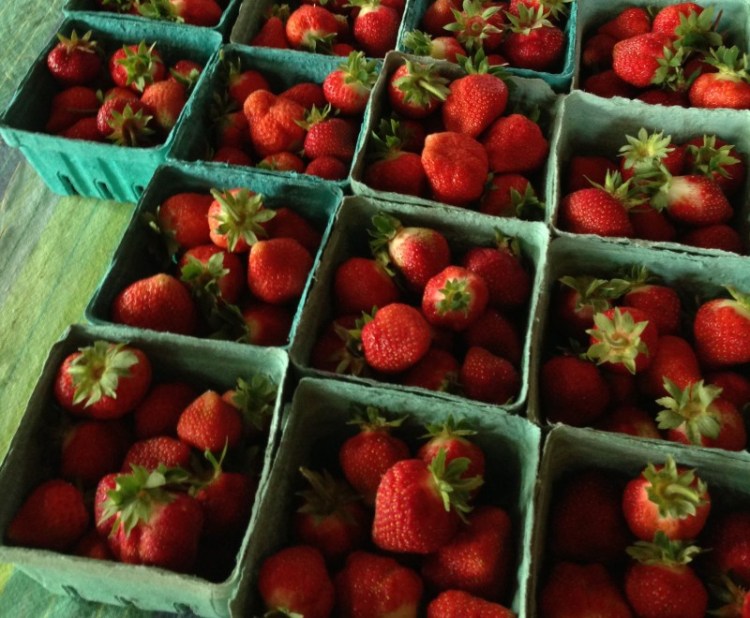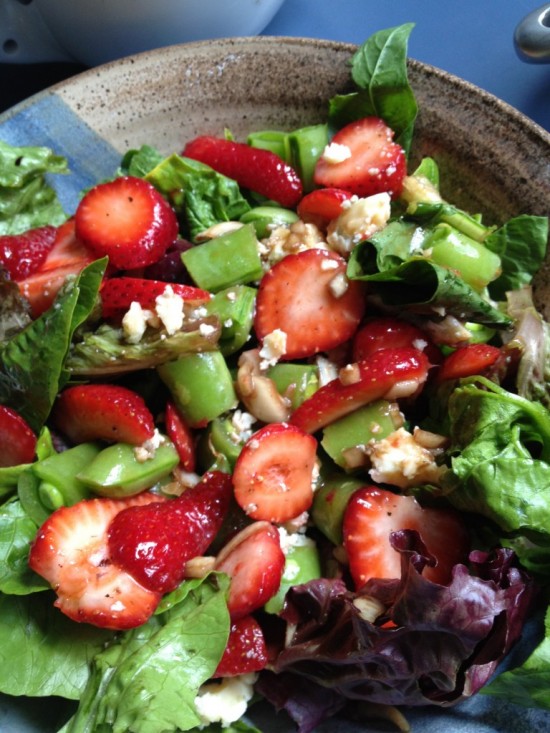Brunswick nurse practitioner Kathy Thorson heeds the “Dirty Dozen” list, an annual ranking by the nonprofit Environmental Working Group of the most pesticide-contaminated crops; this year strawberries come in second (after apples), not the sort of honor you want.
Thorson tries to buy only organic and local versions of these crops. So her family splurges on June’s earliest strawberries from certified organic Six River Farm in Bowdoinham, which sell for $4 a pint at Brunswick markets. But every summer, Thorson and husband Mark Battle, a Bowdoin College physicist, relax their organic ideal to give their kids Zoe, 13, and Felix, 10, the pick-your-own-berries experience at Fairwinds Farm in nearby Bowdoinham.
Although a conventional farm, Fairwinds says they use minimal sprays (only in the bud and blossom stage) – not the much-maligned soil fumigant-herbicide-pesticide cocktail of methyl bromide and tear gas-ingredient chloropicrin used on California’s industrial acres of strawberry monoculture.
Still, Thorson and Battle would prefer an organic option, one that’s close-by and also affordable. And though Thorson once occasionally indulged in those grocery store clamshells of Driscoll strawberries as a winter treat, she now tries to avoid them. They’re horsey-large and often bland, with hollow white cores (though I must admit the organic Driscoll’s I recently tasted were smaller, sweeter and redder than remembered, perhaps because it was peak season in California?).
But at a party last year, Thorson learned to steer clear of Driscoll’s for reasons more insidious than taste alone: a Bowdoin College sociologist shared his research into the company’s obsession with the bottom line – neglecting labor rights and the health of California’s rural communities, where residents must shut their windows, yet still suffer burning eyes on spraying days.
As that sociologist, Marcos Lopez, told me, conventional versus organic isn’t the only debate. Lopez, who studied the labor and environmental abuses around industrial strawberry cultivation in California and Mexico as a University of California, Santa Cruz undergrad and doctoral candidate, says we should also consider big organic versus the small organic we thankfully have access to from local New England farms.
“Small-scale organic is more ecologically sustainable … and better tasting,” Lopez said. “Large-scale organic (e.g., Driscoll) doesn’t care about the environment. They care about profits. This is no generalization – they’ve told me directly.”
But come peak strawberry season, we face a more nuanced dilemma: big organic from faraway versus local, just-picked but conventional strawberries from esteemed farms like Fairwinds, Spear’s in Waldoboro and Stoney End Farm in Rome.
There’s no more nostalgic rite of summer than those annual trips to the u-pick strawberry fields, yet our options for labor-intensive organic are limited. Most of Maine’s pick-your-own strawberry growers use chemical sprays, albeit sparingly. Will we committed, card-carrying MOFGA (Maine Organic Farmers and Gardeners Association)members be endangering our children’s health if we make this summer solstice exception?
LOCAL, NOT NECESSARILY ORGANIC
It’s not worth the risk for some parents, including my friend Sara Cawthon, Bowdoin Organic Garden manager; she will pick organic strawberries from Sheepscot General at Uncas Farms in Whitefield for her 6-month-old daughter, Adley. I plan to take my 3-year-old, Theo, there, too. We haven’t gone strawberry picking since he was just weeks old, in July 2011.
So even though we choose organic, we prefer local to big organic shipped in from afar. Leading locavore chef Dan Barber shares this view in a recent “Vs.” video interview with the website Grist. Barber appreciates local for giving us the chance to “shake the hand that raised the food that I’m eating… With organic from far away, I don’t have that opportunity for engagement. Part of the pleasure with good food is the story that comes with that engagement.”
Barber, a celebrity chef- author from New York’s Blue Hill at Stone Barns, has the power to convince those farmers to consider making the costly, risky shift to organic. We may lack that power as individual consumers, but we shouldn’t dismiss hard-working local farmers just because they aren’t organic.
Chatting at a recent Brunswick Farmers Market, I appreciated how candidly and transparently Fairwinds Farm’s Cathy Karonis answered questions about her strawberry practices. I was thrilled to learn the farm grows some 15 strawberry varieties, a far cry from the few proprietary clones (definitely not picked for fragrance or flavor) grown by the titans. Fairwinds also grows all its strawberries in raised beds now, to make picking easier and to contain disease, so it can apply fungicides and pesticides less often.
Sure, she has contemplated going organic, but Karonis says she can’t risk crop failure or inconsistent quality on her 14 acres of strawberries. So she follows the University of Maine Cooperative Extension’s integrated pest management (IPM) reports instead, judiciously spraying when threats loom. (The high cost of chemicals also keeps their use in check.)
Karonis freely disclosed her farm’s chemical arsenal, and I admit this knowledge makes her conventional berries harder to swallow. Fairwinds usually sprays an herbicide like Devrinol just after the plants cease production. Come spring, the farm applies a fungicide to control gray mold detritus, leather rot and leaf spot. After a bug check of buds, it might employ an insecticide to kill clipper beetles and tarnished plant bugs that cause those “button berries,” robbing the plant of the promise of full, juicy berries (so that’s where my garden strawberries went!).
HARD BUT CROWD-PLEASING
Growing organic strawberries is considerably more stressful and labor-intensive work, hence their high price tag. But the way they lure passionate customers to market, and the pleasure they impart, keeps these intrepid farmers going.
For the second year in a row, organic farms like Goranson in Dresden won’t open their fields for those unpredictable, effortful three weeks of pick-your-own. Jan Goranson says they get more bang for their buck, with much less headache, selling pints at their farm-stand and at the Portland and Bath farmers markets. Last year, Goranson’s suffered root weevils and winter injury because there wasn’t enough insulating snow cover, a problem compounded by a damp cool spring.
“So much can go wrong with organic berries,” Goranson said. “It’s not an easy crop..”
Nor did Sand Hill Farm in Somerville offer organic pick-your-own strawberries last summer. The previous spring (2012) was so wet and rainy, they couldn’t get the field prepped and the crowns planted. Sand Hill plans to open to the public soon.
To keep disease and bugs at bay, Goranson’s and other organic growers now plant strawberries as an annual crop, plowing crowns under after they produce in their second summer. The practice requires plenty of land for at least three-year rotations. These growers also favor annual varieties like Cavendish that come on strong that first year, but whose waning production in subsequent years doesn’t work for perennial growers.
Ben Marcus of the Sheepscot General Store says crowds swamp his 5,000 strawberry crowns. His was one of the few organic pick-your-own operations open last summer, and he had to restrict the number of pickers. Even when the berries grew sparse later into July, the eager were determined to glean whatever the birds and squirrels missed that hadn’t yet rotted in the rain or heat.
“People are clamoring at the gate with strawberry fever,” said Marcus, who expects to open Sheepscot’s fields next weekend.
ALTERNATIVES TO CHEMICALS
Organic strawberries thrive best when farmers plant cover crops, and use labor-saving but environmentally-suspect plastic. On land where he’ll plant strawberries next spring, Marcus is advance-sowing buckwheat and mustard, a natural bio-fumigant to kill off soil fungus. Organic growers plow the crowns under each year, which releases carbon dioxide and could contribute to soil erosion. To offset that, they plant CO2-absorbing cover crops such as oats and red clover, which also control weeds between rows.
Six River Farm’s Andy Wingard said the black plastic mulch that the Bowdoinham farm uses around its strawberry plants that ripen early in a plastic hoop-house also reduces weeding costs. That savings, plus the money not wasted on expensive chemicals, allows organic leaders like Six River to invest in people instead: a summer crew of almost a dozen farmers.
My salad was inspired by one from my Oregon friend Julianna Betjemann, using all local products. Crumbled feta or a blue cheese would also be delicious here. Let’s make a strawberry salad instead of less healthful shortcake a new Maine July 4th tradition!
Strawberry Salad with Snap Peas, Spring Onion, Fennel, Chevre and Balsamic Vinaigrette
Serves 4
6 cups mixed baby greens (preferably spicy), rinsed and dried
Half a spring onion, slivered or chopped
2 tablespoons chopped fennel fronds
1 pint sugar-snap peas, chopped
4 ounces Maine goat cheese, crumbled
Balsamic vinaigrette dressing, to taste
1 pint Maine strawberries, sliced (macerated first in balsamic and a pinch of sugar, if desired)
Sea salt and freshly ground pepper
Place the salad greens in a large bowl. Add the onion, fennel, snap peas and goat cheese. Add dressing and toss to combine.
Layer delicate strawberry slices on top and mix gently. Season with salt and pepper to taste.
Send questions/comments to the editors.



